Beale's Cut (formerly known as both the San Fernando Pass and the Newhall Pass) is located southeast of San Fernando Road between Sierra Highway and the Antelope
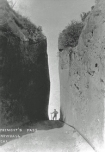 Valley Freeway and has been used in numerous films since the silent era. It became a favorite film location by such pioneer filmmakers as D.W. Griffith, John Ford, Buster Keaton, and Republic Pictures' cliffhanger team of William Witney and John English. One of the earliest cinematic appearances of Beale's Cut was in D.W. Griffith's Broken Ways (1913), a
Biograph starring Harry Carey and Blanche Sweet. John Ford filmed at Beale's Cut several times over a 22-year period, starting with Straight Shooting (1917), Three Jumps Ahead (1923), The Iron Horse (1924), and finally Stagecoach (1939).
Valley Freeway and has been used in numerous films since the silent era. It became a favorite film location by such pioneer filmmakers as D.W. Griffith, John Ford, Buster Keaton, and Republic Pictures' cliffhanger team of William Witney and John English. One of the earliest cinematic appearances of Beale's Cut was in D.W. Griffith's Broken Ways (1913), a
Biograph starring Harry Carey and Blanche Sweet. John Ford filmed at Beale's Cut several times over a 22-year period, starting with Straight Shooting (1917), Three Jumps Ahead (1923), The Iron Horse (1924), and finally Stagecoach (1939).
In John Ford's 5-reeler, Three Jumps Ahead (1923), Tom Mix is seen jumping over Beale's Cut. Careful examination of the jump scene reveals a noticeable size disproportion between the jumping horse, the rider (Mix), and the Cut's physical width. In all likelihood, the "jump" was an early special effects photo composite.
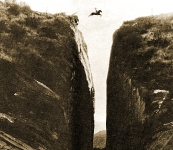 Several stuntmen have claimed credit for this jump, including Andy Jaurejui of Newhall, who apparently doubled for Tom Mix in several promotional trailers for Three Jumps Ahead. Fox Film's Tom Mix was known to have spent quite a bit of time shooting in the Newhall area from 1916 to the mid-1920s. At one time he even ran one of the several Mixville movie
towns in downtown Newhall between San Fernando Road and Newhall Avenue. Mixville eventually would be permanently established in the Silverlake area of Los Angeles. In another film from the 1920s, Buster Keaton's Seven Chances (1925) has the comedian being chased through Beale's Cut by a group of women intent on marrying him. Keaton plays Jimmie Shannon, a financial broker on the verge of bankruptcy who stands to inherit $7 million from his grandfather's will – with the proviso that he must marry before 7 p.m. on his 27th birthday which, by coincidence, happens to be today.
Several stuntmen have claimed credit for this jump, including Andy Jaurejui of Newhall, who apparently doubled for Tom Mix in several promotional trailers for Three Jumps Ahead. Fox Film's Tom Mix was known to have spent quite a bit of time shooting in the Newhall area from 1916 to the mid-1920s. At one time he even ran one of the several Mixville movie
towns in downtown Newhall between San Fernando Road and Newhall Avenue. Mixville eventually would be permanently established in the Silverlake area of Los Angeles. In another film from the 1920s, Buster Keaton's Seven Chances (1925) has the comedian being chased through Beale's Cut by a group of women intent on marrying him. Keaton plays Jimmie Shannon, a financial broker on the verge of bankruptcy who stands to inherit $7 million from his grandfather's will – with the proviso that he must marry before 7 p.m. on his 27th birthday which, by coincidence, happens to be today.
In the late 1930s, John Ford returned to Beale's Cut for a short transitional scene in the feature film Stagecoach (1939): while at Monument Valley, the Apaches began
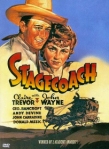 their attack, and for a split moment the stagecoach crossed Beale's Cut, then raced to Lucerne Dry Lake (near Victorville). Beale's Cut became the gateway between Monument Valley and the Lucerne Dry Lake before filming was resumed on Republic Studios' backlot. The magic of early film editing was no better illustrated than in Stagecoach, and movie enthusiasts have long recognized that this feature was filmed at several locations. Throughout Stagecoach, scenes alternate back and forth from Monument Valley to Iverson's Ranch (Chatsworth), across the Kern River (Kernville), and back to Monument Valley. Interestingly, the exact same film sequence starting with the Apache attack at Monument Valley can also be seen as borrowed stock footage in the last five minutes of Columbia's Durango Kid entry Laramie (1949), starring Charles Starrett. In this B-Western, the characters from the Durango movie are seamlessly weaved into the stock footage of Stagecoach's Indian attack sequence - yet another bit of editing magic.
their attack, and for a split moment the stagecoach crossed Beale's Cut, then raced to Lucerne Dry Lake (near Victorville). Beale's Cut became the gateway between Monument Valley and the Lucerne Dry Lake before filming was resumed on Republic Studios' backlot. The magic of early film editing was no better illustrated than in Stagecoach, and movie enthusiasts have long recognized that this feature was filmed at several locations. Throughout Stagecoach, scenes alternate back and forth from Monument Valley to Iverson's Ranch (Chatsworth), across the Kern River (Kernville), and back to Monument Valley. Interestingly, the exact same film sequence starting with the Apache attack at Monument Valley can also be seen as borrowed stock footage in the last five minutes of Columbia's Durango Kid entry Laramie (1949), starring Charles Starrett. In this B-Western, the characters from the Durango movie are seamlessly weaved into the stock footage of Stagecoach's Indian attack sequence - yet another bit of editing magic.
While Beale's Cut was often featured on the big screen, it also played a role in the Saturday matinee cliffhanger. Serials such as Mascot Studio's 12-chapter The Devil Horse (1932), starring Harry Carey; Republic Pictures' 12-chapter The Fighting Devil Dogs (1938), starring Lee Powell, and 12-chapter Adventures of Red Ryder (1940), starring
Don 'Red' Barry, which were both directed by William Witney and John English; and Columbia Pictures' 15-chapter The Phantom (1943) starring Tom Tyler, all have scenes of the famous Cut.
In addition to being an interesting filmmaking site used mainly for two types of shots, either for movement through the Cut or for jumps across the top of it, Beale's Cut was also of historical significance in the development of Newhall.
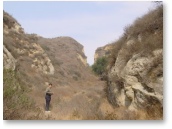 After all, Beale's Cut was once the passage that connected the main roadway between Newhall and the pueblo of Los Angeles.
After all, Beale's Cut was once the passage that connected the main roadway between Newhall and the pueblo of Los Angeles.
The San Fernando Pass was first discovered in August 1769 by Don Gaspar de Portola, who by decree from the King of Spain, Don Carlos III, was seeking a route to facilitate the colonization of Alta California. Once across the Pass, Portola headed west down the Santa Clara River Valley to the coast and then north to Monterey Bay. Padre Francisco Garces is credited with pioneering a trail north through the Tehachapi Mountains into the interior of California. This route would later be used extensively by travelers to
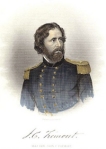 the missions of Alta California. The first major road in California was called El Camino Viejo, "the old road," and it connected Los Angeles and San Francisco. In 1800, El Camino Viejo extended the San Fernando Pass northeast to the Antelope Valley. The discovery of gold on March 9, 1842, by Francisco Lopez in the Canyon de los Encinos (see Walker Ranch) heralded California's first gold rush. Hundreds of prospectors flocked from Los Angeles and Sonora, Mexico, into the region. The influx of miners, merchants, and soldiers increased the traffic through the San Fernando Pass, as did the transport of gold shipments from the region to the Philadelphia Mint. During the Mexican-American War (1846-1848), General John C. Fremont marched his troops through the San Fernando Pass on his way to sign the Cahuenga Capitulation Treaty, which ended the hostilities in California and eventually led to California's statehood. The San Fernando Pass was later renamed Fremont Pass.
the missions of Alta California. The first major road in California was called El Camino Viejo, "the old road," and it connected Los Angeles and San Francisco. In 1800, El Camino Viejo extended the San Fernando Pass northeast to the Antelope Valley. The discovery of gold on March 9, 1842, by Francisco Lopez in the Canyon de los Encinos (see Walker Ranch) heralded California's first gold rush. Hundreds of prospectors flocked from Los Angeles and Sonora, Mexico, into the region. The influx of miners, merchants, and soldiers increased the traffic through the San Fernando Pass, as did the transport of gold shipments from the region to the Philadelphia Mint. During the Mexican-American War (1846-1848), General John C. Fremont marched his troops through the San Fernando Pass on his way to sign the Cahuenga Capitulation Treaty, which ended the hostilities in California and eventually led to California's statehood. The San Fernando Pass was later renamed Fremont Pass.
Although the Pass became widely used, wagons had great difficulty making the climb across the steep grade. Consequently, in 1854 General Phineas Banning made the
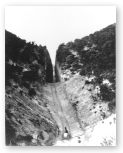 thirty-foot deep cut (Banning Cut) into the Pass, and later that year, the first overland mail service to California - the Butterfield-Overland Stage - came through it. The following year, due to the Kern Canyon Gold Rush, traffic through Fremont Pass almost came to a standstill. To ensure that the Butterfield-Overland Stage could continue mail service to Los Angeles, the County spent $8,000 in 1858 to deepen the Cut. Then, in 1863, General
thirty-foot deep cut (Banning Cut) into the Pass, and later that year, the first overland mail service to California - the Butterfield-Overland Stage - came through it. The following year, due to the Kern Canyon Gold Rush, traffic through Fremont Pass almost came to a standstill. To ensure that the Butterfield-Overland Stage could continue mail service to Los Angeles, the County spent $8,000 in 1858 to deepen the Cut. Then, in 1863, General
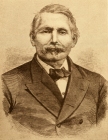 Edward F. Beale, a wealthy landowner and Surveyor-General of California and Nevada, deepened Banning's Cut to 90 feet. At the time, the construction of a toll road across the impassable geographic barrier of the San Gabriel and Santa Susana Mountain ranges represented a significant technological and physical feat. The toll across the Pass varied: a team of
twelve animals cost $2.75; pack animals, horse and man cost twenty-five cents; and loose animals or cattle cost ten cents apiece. A team of horses was kept nearby to assist wagons in getting over the steep grade. The area became known as Beale's Cut. Soon the name Fremont Pass was forgotten and San Fernando Pass was again adopted, but the Cut through the
sandstone mountain would forever be known as Beale's Cut.
Edward F. Beale, a wealthy landowner and Surveyor-General of California and Nevada, deepened Banning's Cut to 90 feet. At the time, the construction of a toll road across the impassable geographic barrier of the San Gabriel and Santa Susana Mountain ranges represented a significant technological and physical feat. The toll across the Pass varied: a team of
twelve animals cost $2.75; pack animals, horse and man cost twenty-five cents; and loose animals or cattle cost ten cents apiece. A team of horses was kept nearby to assist wagons in getting over the steep grade. The area became known as Beale's Cut. Soon the name Fremont Pass was forgotten and San Fernando Pass was again adopted, but the Cut through the
sandstone mountain would forever be known as Beale's Cut.
In 1878, Newhall was founded at its present location and Railroad Avenue became its main street until 1910.
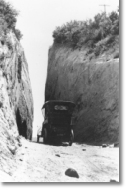 In 1909, the first car travelled through Beale's Cut. The following year, Ridge Route was completed through Newhall, and Spruce Street became the new main street. In the same year, Newhall Highway Tunnel was built to avoid the 29% grade across Beale's Cut. Ridge Route was completed over the Tejon Pass in late November 1915, and Castaic was founded. Between 1919
and 1920, Ridge Route was paved with reinforced concrete, and the following year saw the completion of Mint Canyon Road (Sierra Highway). Until the completion of the three-lane Newhall Alternate through Weldon Canyon in 1930, the only way to Newhall was via Ridge Route or Mint Canyon Road. In 1938, the new Sierra Highway (US 6) bypassed Newhall and Saugus, and the Newhall Tunnel was eliminated. Over the next three decades, the existing thoroughfares were straightened, paved, and widened. In 1963, the new Antelope Valley Freeway (SR 14) was completed from Red Rover Mine Road to near Solemint Junction.
In 1909, the first car travelled through Beale's Cut. The following year, Ridge Route was completed through Newhall, and Spruce Street became the new main street. In the same year, Newhall Highway Tunnel was built to avoid the 29% grade across Beale's Cut. Ridge Route was completed over the Tejon Pass in late November 1915, and Castaic was founded. Between 1919
and 1920, Ridge Route was paved with reinforced concrete, and the following year saw the completion of Mint Canyon Road (Sierra Highway). Until the completion of the three-lane Newhall Alternate through Weldon Canyon in 1930, the only way to Newhall was via Ridge Route or Mint Canyon Road. In 1938, the new Sierra Highway (US 6) bypassed Newhall and Saugus, and the Newhall Tunnel was eliminated. Over the next three decades, the existing thoroughfares were straightened, paved, and widened. In 1963, the new Antelope Valley Freeway (SR 14) was completed from Red Rover Mine Road to near Solemint Junction.
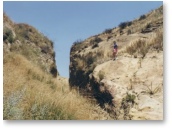 Four years later, Interstate 5 was completed through Santa Clarita Valley, followed by the extension of Antelope Valley Freeway from Solemint Junction to Interstate 5. Lastly, in 1989, San Fernando Road was widened from Sierra Highway to Newhall.
Four years later, Interstate 5 was completed through Santa Clarita Valley, followed by the extension of Antelope Valley Freeway from Solemint Junction to Interstate 5. Lastly, in 1989, San Fernando Road was widened from Sierra Highway to Newhall.
Beale's Cut, once the gateway between Los Angeles and Newhall and points north, has long since been bypassed by faster, wider, and better thoroughfares. Today, Beale's Cut is located just southeast of San Fernando Road between Sierra Highway and the Antelope Valley Freeway. And even though a massive landslide in the spring of 1998 filled in nearly half of the
Cut, this technological feat of a bygone era is still certainly worth visiting.